SD item set v1.18.11 removed items
MDS3.0_SD_Dschg_v1.17.2 + removed items redlined.docx
Minimum Data Set 3.0 Nursing Home and Swing Bed Prospective Payment System (PPS) for the Collection of Data Related to the Patient Driven Payment Model and the Skilled Nursing Facility QRP (CMS-10387)
SD item set v1.18.11 removed items
OMB: 0938-1140
Resident
Identifier
Date







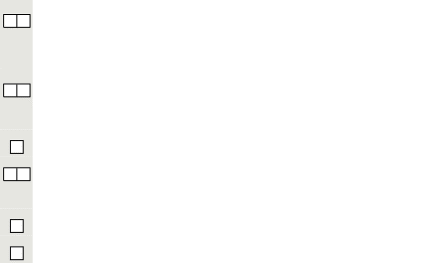
RESIDENT ASSESSMENT AND CARE SCREENING
 Swing
Bed
Discharge
(SD)
Item
Set
Swing
Bed
Discharge
(SD)
Item
Set
Section A |
Identification Information |
|
A0050. Type of Record |
||
Enter Code |
|
|
A0100. Facility Provider Numbers |
||
|
|
|
A0200. Type of Provider. |
||
Enter Code |
Type of provider
|
|
A0310. Type of Assessment |
||
Enter Code
Enter Code
Enter Code
Enter Code
Enter Code
Enter Code |
A. Federal OBRA Reason for Assessment
99. None of the above |
|
B. PPS Assessment. PPS Scheduled Assessment for a Medicare Part A Stay 01. 5-day scheduled assessment PPS Unscheduled Assessment for a Medicare Part A Stay. 08. IPA - Interim Payment Assessment Not PPS Assessment 99. None of the above |
||
E. Is this assessment the first assessment (OBRA, Scheduled PPS, or Discharge) since the most recent admission/entry or reentry?
|
||
F. Entry/discharge reporting 01. Entry tracking record
99. None of the above |
||
G. Type of discharge - Complete only if A0310F = 10 or 11
|
||
G1. Is this a SNF Part A Interrupted Stay?
|
||
A0310 continued on next page |
||
Section A |
Identification Information |
|
A0310. Type of Assessment - Continued |
||
Enter Code |
H. Is this a SNF Part A PPS Discharge Assessment?
|
|
A0410. Unit Certification or Licensure Designation |
||
Enter Code |
|
|
A0500. Legal Name of Resident. |
||
|
A. First name: B. Middle initial:
C. Last name: D. Suffix: |
|
A0600. Social Security and Medicare Numbers |
||
|
A. Social Security Number: _ _
B. Medicare number: |
|
A0700. Medicaid Number - Enter "+" if pending, "N" if not a Medicaid recipient |
||
|
|
|
A0800. Gender |
||
Enter Code |
|
|
A0900. Birth Date |
||
|
_ _ Month Day Year |
|
|
||
|
||
|
|
|
|
||
|
||
|
||
|
||
|
||































Section A |
Identification Information |
|
|
||
Enter Code |
|
|
|
||
A1200. Marital Status |
||
Enter Code |
|
|
A1300. Optional Resident Items |
||
|
|
|
Most Recent Admission/Entry or Reentry into this Facility |
|
A1600. Entry Date |
|
|
_ _ Month Day Year |
A1700. Type of Entry |
|
Enter Code |
|
|
|
Enter Code |
|
A1900. Admission Date (Date this episode of care in this facility began) |
|
|
_ _ Month Day Year |
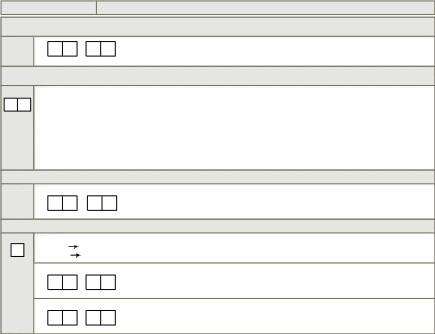 Section
A
Section
A
A2000. Discharge Date
Identification Information
Complete only if A0310F = 10, 11, or 12
_
Month
_
Day
|
|
|
|
Year
A2100.
Discharge
Status
Replaced with A2105 Discharge Status
Complete
only
if
A0310F
=
10,
11,
or
12
Enter
Code
Community(privatehome/apt.,board/care,assistedliving,grouphome)Anothernursinghome orswing bedAcutehospitalPsychiatrichospitalInpatientrehabilitationfacilityID/DDfacility.HospiceDeceasedLongTermCareHospital(LTCH)
99.
Other
A2300. Assessment Reference Date
Observation end date:
_
Month
A2400. Medicare Stay
_
Day

Enter Code
Has the resident had a Medicare-covered stay since the most recent entry?
No Skip to B0100, Comatose
Yes Continue to A2400B, Start date of most recent Medicare stay
Start date of most recent Medicare stay:
_
Month
_
Day
|
|
|
|
Year
End date of most recent Medicare stay - Enter dashes if stay is ongoing:
_
 Month
Month
_
Day
|
|
|
|
Year


Section B |
Hearing, Speech, and Vision |
|
B0100. Comatose |
||
Enter Code |
Persistent vegetative state/no discernible consciousness
|
|
![]()


![]()
![]()




C0100. Should Brief Interview for Mental Status (C0200-C0500) be Conducted? If A0310G = 2 skip to C0700. Otherwise, attempt to conduct interview with all residents |
|
Enter Code |
|
Brief Interview for Mental Status (BIMS) |
|||
C0200. Repetition of Three Words |
|||
Enter Code |
Ask resident: “I am going to say three words for you to remember. Please repeat the words after I have said all three. The words are: sock, blue, and bed. Now tell me the three words.” Number of words repeated after first attempt
After the resident's first attempt, repeat the words using cues ("sock, something to wear; blue, a color; bed, a piece of furniture"). You may repeat the words up to two more times. |
||
C0300. Temporal Orientation (orientation to year, month, and day) |
|||
Enter Code
Enter Code
Enter Code |
Ask resident: "Please tell me what year it is right now." A. Able to report correct year
|
||
Ask resident: "What month are we in right now?" B. Able to report correct month
|
|||
Ask resident: "What day of the week is today?" C. Able to report correct day of the week
|
|||
C0400. Recall |
|||
Enter Code
Enter Code
Enter Code |
Ask resident: "Let's go back to an earlier question. What were those three words that I asked you to repeat?" If unable to remember a word, give cue (something to wear; a color; a piece of furniture) for that word. A. Able to recall "sock"
|
||
B. Able to recall "blue"
|
|||
C. Able to recall "bed"
|
|||
C0500. BIMS Summary Score |
|||
Enter Score |
Add scores for questions C0200-C0400 and fill in total score (00-15) Enter 99 if the resident was unable to complete the interview |
||
|
|
|
|



![]()
![]()



C0600. Should the Staff Assessment for Mental Status (C0700 - C1000) be Conducted? |
|
Enter Code |
|
Staff Assessment for Mental Status |
|
Do not conduct if Brief Interview for Mental Status (C0200-C0500) was completed |
|
C0700. Short-term Memory OK |
|
Enter Code |
Seems or appears to recall after 5 minutes
|
C1000. Cognitive Skills for Daily Decision Making |
|
Enter Code |
Made decisions regarding tasks of daily life
|
Delirium |
|||
C1310. Signs and Symptoms of Delirium (from CAM©) |
|||
Code after completing Brief Interview for Mental Status or Staff Assessment, and reviewing medical record |
|||
A. Acute Onset Mental Status Change |
|||
Enter Code |
Is there evidence of an acute change in mental status from the resident's baseline?
|
||
Coding:
|
Enter Codes in Boxes |
||
|
B. Inattention - Did the resident have difficulty focusing attention, for example, being easily distractible or having difficulty keeping track of what was being said? |
||
C. Disorganized Thinking - Was the resident's thinking disorganized or incoherent (rambling or irrelevant conversation, unclear or illogical flow of ideas, or unpredictable switching from subject to subject)? |
|||
D. Altered Level of Consciousness - Did the resident have altered level of consciousness, as indicated by any of the following criteria?
|
|||
Confusion Assessment Method. ©1988, 2003, Hospital Elder Life Program. All rights reserved. Adapted from: Inouye SK et al. Ann Intern Med. 1990; 113:941-8. Used with permission. |
|||



![]()
![]()
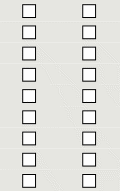

D0100. Should Resident Mood Interview be Conducted? - If A0310G = 2 skip to E0100. Otherwise, attempt to conduct interview with all residents |
|
Enter Code |
|
|
|||
|
|||
|
|||
|
|
|
|
|
|||
|
|
|
|
|
|
|
|
|
|
|
|
|
|
|
|
|
|
|
|
|
|
|
|
|
|
|
|
|
|
|
|
|
|
|
|
|
|||
|
|
||
![]() Copyright
©
Pfizer
Inc.
All
rights
reserved.
Reproduced
with
permission.
Copyright
©
Pfizer
Inc.
All
rights
reserved.
Reproduced
with
permission.
D0500.
Staff
Assessment
of
Resident
Mood
(PHQ-9-OV*) Do
not
conduct
if
Resident
Mood
Interview
(D0200-D0300)
was
completed
Over
the
last
2
weeks,
did
the
resident
have
any
of
the
following
problems
or
behaviors?
If
symptom
is
present,
enter
1
(yes)
in
column
1,
Symptom
Presence. Then
move
to
column
2,
Symptom
Frequency,
and
indicate
symptom
frequency. Symptom
Presence 2.
Symptom
Frequency. No
(enter
0
in
column
2) 0.
Never
or
1
day Yes
(enter
0-3
in
column
2) 1.
2-6
days
(several
days) 7-11
days
(half
or
more
of
the
days) 12-14
days
(nearly
every
day)
1.
Symptom
Presence
2.
Symptom
Frequency
A.
Little
interest
or
pleasure
in
doing
things
B.
Feeling
or
appearing
down,
depressed,
or
hopeless
C.
Trouble
falling
or
staying
asleep,
or
sleeping
too
much
D.
Feeling
tired
or
having
little
energy
E.
Poor
appetite
or
overeating
F.
Indicating
that
s/he
feels
bad
about
self,
is
a
failure,
or
has
let
self
or
family
down
G.
Trouble
concentrating
on
things,
such
as
reading
the
newspaper
or
watching
television
H.
Moving
or speaking so slowly that other people have noticed.
Or
the opposite - being so fidgety or
restless
that
s/he
has
been
moving
around
a
lot
more
than
usual
I.
States
that
life
isn't
worth
living,
wishes
for
death,
or
attempts
to
harm
self
J.
Being
short-tempered,
easily
annoyed
D0600.
Total
Severity
Score
Enter
Score
Add
scores
for
all
frequency
responses
in
Column
2,
Symptom
Frequency.
Total
score
must
be
between
00
and
30.
![]() Enter
Scores in Boxes
Enter
Scores in Boxes
![]()
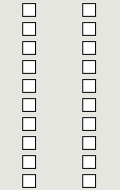

* Copyright © Pfizer Inc. All rights reserved.
Section E |
Behavior |
|||
E0100. Potential Indicators of Psychosis |
||||
Check all that apply |
||||
|
A. Hallucinations (perceptual experiences in the absence of real external sensory stimuli) |
|||
B. Delusions (misconceptions or beliefs that are firmly held, contrary to reality) |
||||
Z. None of the above |
||||
Behavioral Symptoms |
||||
E0200. Behavioral Symptom - Presence & Frequency |
||||
Note presence of symptoms and their frequency. |
||||
Coding:
but less than daily
|
Enter Codes in Boxes |
|||
|
A. Physical behavioral symptoms directed toward others (e.g., hitting, kicking, pushing, scratching, grabbing, abusing others sexually) |
|||
B. Verbal behavioral symptoms directed toward others (e.g., threatening others, screaming at others, cursing at others) |
||||
C. Other behavioral symptoms not directed toward others (e.g., physical symptoms such as hitting or scratching self, pacing, rummaging, public sexual acts, disrobing in public, throwing or smearing food or bodily wastes, or verbal/vocal symptoms like screaming, disruptive sounds) |
||||
E0800. Rejection of Care - Presence & Frequency |
||||
Enter Code |
Did the resident reject evaluation or care (e.g., bloodwork, taking medications, ADL assistance) that is necessary to achieve the resident's goals for health and well-being? Do not include behaviors that have already been addressed (e.g., by discussion or care planning with the resident or family), and determined to be consistent with resident values, preferences, or goals.
|
|||
E0900. Wandering - Presence & Frequency |
||||
Enter Code |
Has the resident wandered?
|
|||





|
|
||
|
|||
|
|||
|
|||
|
|
|
|
|
|||
|
|
|
|
|
|||
|
|||
|
|||
|
|||
|
|||
|
|||
|
|||
|
|||
|
|||
![]()
![]()



|
|
|
|
||
|
||
|
|
|
Section GG |
Functional Abilities and Goals - Discharge (End of SNF PPS Stay) |
|
GG0130. Self-Care (Assessment period is the last 3 days of the SNF PPS Stay ending on A2400C) Complete only if A0310G is not = 2 and A0310H = 1 and A2400C minus A2400B is greater than 2 and A2100 is not = 03 |
||
Code the resident's usual performance at the end of the SNF PPS stay for each activity using the 6-point scale. If an activity was not attempted at the end of the SNF PPS stay, code the reason. |
||
Coding: Safety and Quality of Performance - If helper assistance is required because resident's performance is unsafe or of poor quality, score according to amount of assistance provided. Activities may be completed with or without assistive devices. 06. Independent - Resident completes the activity by him/herself with no assistance from a helper. 05. Setup or clean-up assistance - Helper sets up or cleans up; resident completes activity. Helper assists only prior to or following the activity. 04. Supervision or touching assistance - Helper provides verbal cues and/or touching/steadying and/or contact guard assistance as resident completes activity. Assistance may be provided throughout the activity or intermittently. 03. Partial/moderate assistance - Helper does LESS THAN HALF the effort. Helper lifts, holds, or supports trunk or limbs, but provides less than half the effort. 02. Substantial/maximal assistance - Helper does MORE THAN HALF the effort. Helper lifts or holds trunk or limbs and provides more than half the effort. 01. Dependent - Helper does ALL of the effort. Resident does none of the effort to complete the activity. Or, the assistance of 2 or more helpers is required for the resident to complete the activity. If activity was not attempted, code reason: 07. Resident refused 09. Not applicable - Not attempted and the resident did not perform this activity prior to the current illness, exacerbation, or injury. 10. Not attempted due to environmental limitations (e.g., lack of equipment, weather constraints) 88. Not attempted due to medical condition or safety concerns |
||
3. Discharge Performance |
|
|
Enter Codes in Boxes
|
||
|
A. Eating: The ability to use suitable utensils to bring food and/or liquid to the mouth and swallow food and/or liquid once the meal is placed before the resident. |
|
B. Oral hygiene: The ability to use suitable items to clean teeth. Dentures (if applicable): The ability to insert and remove dentures into and from the mouth, and manage denture soaking and rinsing with use of equipment. |
||
C. Toileting hygiene: The ability to maintain perineal hygiene, adjust clothes before and after voiding or having a bowel movement. If managing an ostomy, include wiping the opening but not managing equipment.. |
||
E. Shower/bathe self: The ability to bathe self, including washing, rinsing, and drying self (excludes washing of back and hair). Does not include transferring in/out of tub/shower. |
||
F. Upper body dressing: The ability to dress and undress above the waist; including fasteners, if applicable. |
||
G. Lower body dressing: The ability to dress and undress below the waist, including fasteners; does not include footwear. |
||
H. Putting on/taking off footwear: The ability to put on and take off socks and shoes or other footwear that is appropriate for safe mobility; including fasteners, if applicable. |
||
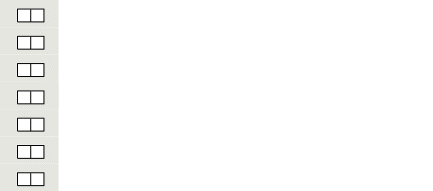
Section GG |
Functional Abilities and Goals - Discharge (End of SNF PPS Stay) |
|
GG0170. Mobility (Assessment period is the last 3 days of the SNF PPS Stay ending on A2400C) Complete only if A0310G is not = 2 and A0310H = 1 and A2400C minus A2400B is greater than 2 and A2100 is not = 03 |
||
Code the resident's usual performance at the end of the SNF PPS stay for each activity using the 6-point scale. If an activity was not attempted at the end of the SNF PPS stay, code the reason. |
||
Coding: Safety and Quality of Performance - If helper assistance is required because resident's performance is unsafe or of poor quality, score according to amount of assistance provided. Activities may be completed with or without assistive devices. 06. Independent - Resident completes the activity by him/herself with no assistance from a helper. 05. Setup or clean-up assistance - Helper sets up or cleans up; resident completes activity. Helper assists only prior to or following the activity. 04. Supervision or touching assistance - Helper provides verbal cues and/or touching/steadying and/or contact guard assistance as resident completes activity. Assistance may be provided throughout the activity or intermittently. 03. Partial/moderate assistance - Helper does LESS THAN HALF the effort. Helper lifts, holds, or supports trunk or limbs, but provides less than half the effort. 02. Substantial/maximal assistance - Helper does MORE THAN HALF the effort. Helper lifts or holds trunk or limbs and provides more than half the effort. 01. Dependent - Helper does ALL of the effort. Resident does none of the effort to complete the activity. Or, the assistance of 2 or more helpers is required for the resident to complete the activity. If activity was not attempted, code reason: 07. Resident refused 09. Not applicable - Not attempted and the resident did not perform this activity prior to the current illness, exacerbation, or injury. 10. Not attempted due to environmental limitations (e.g., lack of equipment, weather constraints) 88. Not attempted due to medical condition or safety concerns |
||
3. Discharge Performance |
|
|
Enter Codes in Boxes
|
||
|
A. Roll left and right: The ability to roll from lying on back to left and right side, and return to lying on back on the bed. |
|
B. Sit to lying: The ability to move from sitting on side of bed to lying flat on the bed. |
||
C. Lying to sitting on side of bed: The ability to move from lying on the back to sitting on the side of the bed with feet flat on the floor, and with no back support. |
||
D. Sit to stand: The ability to come to a standing position from sitting in a chair, wheelchair, or on the side of the bed.. |
||
E. Chair/bed-to-chair transfer: The ability to transfer to and from a bed to a chair (or wheelchair). |
||
F. Toilet transfer: The ability to get on and off a toilet or commode. |
||
G. Car transfer: The ability to transfer in and out of a car or van on the passenger side. Does not include the ability to open/ close door or fasten seat belt. |
||
I. Walk 10 feet: Once standing, the ability to walk at least 10 feet in a room, corridor, or similar space. If discharge performance is coded 07, 09, 10, or 88 Skip to GG0170M, 1 step (curb) |
||
J. Walk 50 feet with two turns: Once standing, the ability to walk at least 50 feet and make two turns. |
||
K. Walk 150 feet: Once standing, the ability to walk at least 150 feet in a corridor or similar space. |
||


![]()
![]()
![]()
![]()
Section GG |
Functional Abilities and Goals - Discharge (End of SNF PPS Stay) |
||
GG0170. Mobility (Assessment period is the last 3 days of the SNF PPS Stay ending on A2400C) - Continued Complete only if A0310G is not = 2 and A0310H = 1 and A2400C minus A2400B is greater than 2 and A2100 is not = 03 |
|||
Code the resident's usual performance at the end of the SNF PPS stay for each activity using the 6-point scale. If an activity was not attempted at the end of the SNF PPS stay, code the reason. |
|||
Coding: Safety and Quality of Performance - If helper assistance is required because resident's performance is unsafe or of poor quality, score according to amount of assistance provided. Activities may be completed with or without assistive devices. 06. Independent - Resident completes the activity by him/herself with no assistance from a helper. 05. Setup or clean-up assistance - Helper sets up or cleans up; resident completes activity. Helper assists only prior to or following the activity. 04. Supervision or touching assistance - Helper provides verbal cues and/or touching/steadying and/or contact guard assistance as resident completes activity. Assistance may be provided throughout the activity or intermittently. 03. Partial/moderate assistance - Helper does LESS THAN HALF the effort. Helper lifts, holds, or supports trunk or limbs, but provides less than half the effort. 02. Substantial/maximal assistance - Helper does MORE THAN HALF the effort. Helper lifts or holds trunk or limbs and provides more than half the effort. 01. Dependent - Helper does ALL of the effort. Resident does none of the effort to complete the activity. Or, the assistance of 2 or more helpers is required for the resident to complete the activity. If activity was not attempted, code reason: 07. Resident refused 09. Not applicable - Not attempted and the resident did not perform this activity prior to the current illness, exacerbation, or injury. 10. Not attempted due to environmental limitations (e.g., lack of equipment, weather constraints) 88. Not attempted due to medical condition or safety concerns |
|||
3. Discharge Performance |
|
||
Enter Codes in Boxes
|
|||
|
L. Walking 10 feet on uneven surfaces: The ability to walk 10 feet on uneven or sloping surfaces (indoor or outdoor), such as turf or gravel. |
||
M. 1 step (curb): The ability to go up and down a curb and/or up and down one step. If discharge performance is coded 07, 09, 10, or 88 Skip to GG0170P, Picking up object. |
|||
N. 4 steps: The ability to go up and down four steps with or without a rail. If discharge performance is coded 07, 09, 10, or 88 Skip to GG0170P, Picking up object. |
|||
O. 12 steps: The ability to go up and down 12 steps with or without a rail. |
|||
P. Picking up object: The ability to bend/stoop from a standing position to pick up a small object, such as a spoon, from the floor. |
|||
|
Q3. Does the resident use a wheelchair and/or scooter?
|
||
R. Wheel 50 feet with two turns: Once seated in wheelchair/scooter, the ability to wheel at least 50 feet and make two turns. |
|||
|
RR3. Indicate the type of wheelchair or scooter used.
|
||
S. Wheel 150 feet: Once seated in wheelchair/scooter, the ability to wheel at least 150 feet in a corridor or similar space. |
|||
|
SS3. Indicate the type of wheelchair or scooter used.
|
||




Section H |
Bladder and Bowel |
|
H0100. Appliances |
||
|
||
|
A. Indwelling catheter (including suprapubic catheter and nephrostomy tube) |
|
B. External catheter |
||
C. Ostomy (including urostomy, ileostomy, and colostomy) |
||
D. Intermittent catheterization |
||
Z. None of the above |
||
H0300. Urinary Continence |
||
Enter Code |
Urinary continence - Select the one category that best describes the resident
9. Not rated, resident had a catheter (indwelling, condom), urinary ostomy, or no urine output for the entire 7 days |
|
H0400. Bowel Continence |
||
Enter Code |
Bowel continence - Select the one category that best describes the resident
9. Not rated, resident had an ostomy or did not have a bowel movement for the entire 7 days |
|
Section I |
Active Diagnoses |
|
Active Diagnoses in the last 7 days - Check all that apply Diagnoses listed in parentheses are provided as examples and should not be considered as all-inclusive lists |
||
|
Heart/Circulation |
|
I0900. Peripheral Vascular Disease (PVD) or Peripheral Arterial Disease (PAD) |
||
Genitourinary |
||
I1550. Neurogenic Bladder I1650. Obstructive Uropathy |
||
Infections |
||
I2300. Urinary Tract Infection (UTI) (LAST 30 DAYS) |
||
Metabolic |
||
I2900. Diabetes Mellitus (DM) (e.g., diabetic retinopathy, nephropathy, and neuropathy) |
||
Neurological |
||
I5250. Huntington's Disease I5350. Tourette's Syndrome |
||
Nutritional |
||
I5600. Malnutrition (protein or calorie) or at risk for malnutrition |
||
Psychiatric/Mood Disorder |
||
I5700. Anxiety Disorder I5900. Bipolar Disorder I5950. Psychotic Disorder (other than schizophrenia) I6000. Schizophrenia (e.g., schizoaffective and schizophreniform disorders) I6100. Post Traumatic Stress Disorder (PTSD) |
||
Other |
||
I8000. Additional active diagnoses Enter diagnosis on line and ICD code in boxes. Include the decimal for the code in the appropriate box.
A.
B.
C.
D.
E.
F.
G.
H.
I.
J. |
||










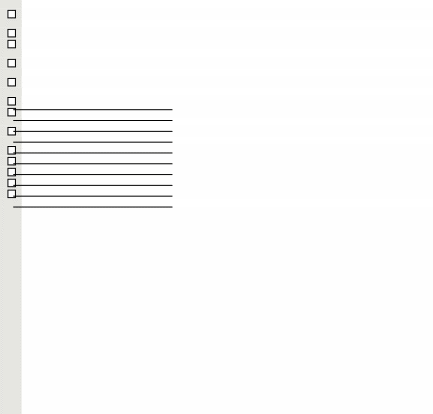
![]()



![]()
![]()
![]()
![]()
![]()




Section J |
Health Conditions |
|
J0100. Pain Management - Complete for all residents, regardless of current pain level |
||
At any time in the last 5 days, has the resident: |
||
Enter Code
Enter Code
Enter Code |
A. Received scheduled pain medication regimen?
|
|
B. Received PRN pain medications OR was offered and declined?
|
||
C. Received non-medication intervention for pain?
|
||
J0200. Should Pain Assessment Interview be Conducted? If resident is comatose or if A0310G = 2 , skip to J1100, Shortness of Breath (dyspnea). Otherwise, attempt to conduct interview with all residents |
|
Enter Code |
|
Pain Assessment Interview |
|
J0300. Pain Presence |
|
Enter Code |
Ask resident: "Have you had pain or hurting at any time in the last 5 days?"
9. Unable to answer Skip to J1100, Shortness of Breath (dyspnea) |
|
|
|
|
|
|
Enter Code
Enter Code |
|
|
|
|
|
|
|
|
|
Section J |
Health Conditions |
||
Other Health Conditions |
|||
J1100. Shortness of Breath (dyspnea) |
|||
Check all that apply |
|||
|
A. Shortness of breath or trouble breathing with exertion (e.g., walking, bathing, transferring) |
||
B. Shortness of breath or trouble breathing when sitting at rest. |
|||
C. Shortness of breath or trouble breathing when lying flat |
|||
Z. None of the above |
|||
J1400. Prognosis |
|||
Enter Code |
Does the resident have a condition or chronic disease that may result in a life expectancy of less than 6 months? (Requires physician documentation)
|
||
J1550. Problem Conditions |
|||
Check all that apply |
|||
|
A. Fever |
||
B. Vomiting |
|||
C. Dehydrated |
|||
D. Internal bleeding |
|||
Z. None of the above |
|||
J1800. Any Falls Since Admission/Entry or Reentry or Prior Assessment (OBRA or Scheduled PPS), whichever is more recent |
|||
Enter Code |
Has the resident had any falls since admission/entry or reentry or the prior assessment (OBRA or Scheduled PPS), whichever is more recent?
|
||
J1900. Number of Falls Since Admission/Entry or Reentry or Prior Assessment (OBRA or Scheduled PPS), whichever is more recent |
|||
Coding:
|
Enter Codes in Boxes |
||
|
A. No injury - no evidence of any injury is noted on physical assessment by the nurse or primary care clinician; no complaints of pain or injury by the resident; no change in the resident's behavior is noted after the fall |
||
B. Injury (except major) - skin tears, abrasions, lacerations, superficial bruises, hematomas and sprains; or any fall-related injury that causes the resident to complain of pain |
|||
C. Major injury - bone fractures, joint dislocations, closed head injuries with altered consciousness, subdural hematoma |
|||
![]()





Section K |
Swallowing/Nutritional Status |
||||
K0200. Height and Weight - While measuring, if the number is X.1 - X.4 round down; X.5 or greater round up |
|||||
inches
pounds |
A. Height (in inches). Record most recent height measure since admission/entry or reentry |
||||
B. Weight (in pounds). Base weight on most recent measure in last 30 days; measure weight consistently, according to standard facility practice (e.g., in a.m. after voiding, before meal, with shoes off, etc.) |
|||||
K0300. Weight Loss |
|||||
Enter Code |
Loss of 5% or more in the last month or loss of 10% or more in last 6 months
|
||||
K0310. Weight Gain |
|||||
Enter Code |
Gain of 5% or more in the last month or gain of 10% or more in last 6 months
|
||||
|
|||||
|
1. While NOT a Resident. |
2. While a Resident |
|||
Check all that apply |
|||||
|
|
|
|||
|
|||||
|
|||||
|
|
|
|||
|
|||||
|
|
||||






Section M |
Skin Conditions |
|
Report based on highest stage of existing ulcers/injuries at their worst; do not "reverse" stage |
||
M0100. Determination of Pressure Ulcer/Injury Risk. |
||
Check all that apply |
||
|
A. Resident has a pressure ulcer/injury, a scar over bony prominence, or a non-removable dressing/device. |
|
M0210. Unhealed Pressure Ulcers/Injuries |
||
Enter Code |
Does this resident have one or more unhealed pressure ulcers/injuries?
|
|
M0300. Current Number of Unhealed Pressure Ulcers/Injuries at Each Stage |
||
Enter Number
Enter Number
Enter Number
Enter Number
Enter Number
Enter Number
Enter Number
Enter Number
Enter Number
Enter Number |
B. Stage 2: Partial thickness loss of dermis presenting as a shallow open ulcer with a red or pink wound bed, without slough. May also present as an intact or open/ruptured blister
|
|
|
||
M0300 continued on next page |
||



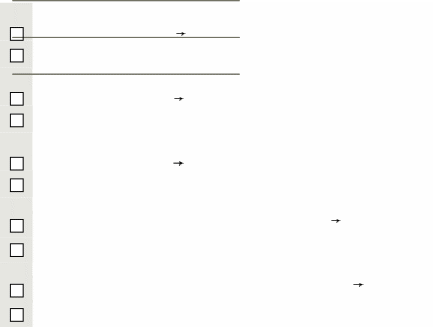


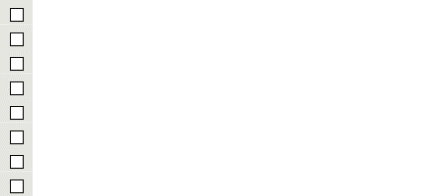

Section M |
Skin Conditions |
|
M0300 - Continued |
||
Enter Number
Enter Number |
G. Unstageable - Deep tissue injury:
|
|
Section N |
Medications |
|
|
||
|
||
|
|
|
|
||
|
||
|
||
|
||
|
||
|
||
|
|
|
N2005. Medication Intervention - Complete only if A0310H = 1 |
||
Enter Code |
Did the facility contact and complete physician (or physician-designee) prescribed/recommended actions by midnight of the next calendar day each time potential clinically significant medication issues were identified since the admission? 0. No 1. Yes 9. NA - There were no potential clinically significant medication issues identified since admission or resident is not taking any medications |
|
|
|
|||
|
||||
|
1. While NOT a Resident. |
2. While a Resident |
||
Check all that apply |
||||
|
|
|
||
O0250. Influenza Vaccine - Refer to current version of RAI manual for current influenza vaccination season and reporting period |
||||
Enter Code
Enter Code |
A. Did the resident receive the influenza vaccine in this facility for this year's influenza vaccination season?
|
|||
B. Date influenza vaccine received Complete date and skip to O0300A, Is the resident's Pneumococcal vaccination up to date? _ _ Month Day Year |
||||
C. If influenza vaccine not received, state reason:
9. None of the above. |
||||
O0300. Pneumococcal Vaccine. |
||||
Enter Code |
A. Is the resident's Pneumococcal vaccination up to date?
|
|||
Enter Code |
B. If Pneumococcal vaccine not received, state reason:
|
|||




![]()

Section O
O0425. Part A Therapies
Complete only if A0310H = 1
Special Treatments, Procedures, and Programs
Enter Number of Minutes
Enter Number of Minutes
Enter Number of Minutes
Enter Number of Minutes
Enter Number of Days
Enter Number of Minutes
Enter Number of Minutes
Enter Number of Minutes
Enter Number of Minutes
Enter Number of Days
Enter Number of Minutes
Enter Number of Minutes
Enter Number of Minutes
Enter Number of Minutes
Enter Number of Days
Speech-Language Pathology and Audiology Services

Individual minutes - record the total number of minutes this therapy was administered to the resident individually
since the start date of the resident's most recent Medicare Part A stay (A2400B)

Concurrent minutes - record the total number of minutes this therapy was administered to the resident concurrently with one other resident since the start date of the resident's most recent Medicare Part A stay (A2400B)

Group minutes - record the total number of minutes this therapy was administered to the resident as part of a group of residents since the start date of the resident's most recent Medicare Part A stay (A2400B)
If the sum of individual, concurrent, and group minutes is zero, skip to O0425B, Occupational Therapy

Co-treatment minutes - record the total number of minutes this therapy was administered to the resident in
co-treatment sessions since the start date of the resident's most recent Medicare Part A stay (A2400B)
Days - record the number of days this therapy was administered for at least 15 minutes a day since the start date of the resident's most recent Medicare Part A stay (A2400B)
Occupational Therapy

Individual minutes - record the total number of minutes this therapy was administered to the resident individually
since the start date of the resident's most recent Medicare Part A stay (A2400B)

Concurrent minutes - record the total number of minutes this therapy was administered to the resident concurrently with one other resident since the start date of the resident's most recent Medicare Part A stay (A2400B)

Group minutes - record the total number of minutes this therapy was administered to the resident as part of a group of residents since the start date of the resident's most recent Medicare Part A stay (A2400B)
If the sum of individual, concurrent, and group minutes is zero, skip to O0425C, Physical Therapy

Co-treatment minutes - record the total number of minutes this therapy was administered to the resident in
co-treatment sessions since the start date of the resident's most recent Medicare Part A stay (A2400B)
Days - record the number of days this therapy was administered for at least 15 minutes a day since the start date of the resident's most recent Medicare Part A stay (A2400B)
Physical Therapy

Individual minutes - record the total number of minutes this therapy was administered to the resident individually
since the start date of the resident's most recent Medicare Part A stay (A2400B)

Concurrent minutes - record the total number of minutes this therapy was administered to the resident concurrently with one other resident since the start date of the resident's most recent Medicare Part A stay (A2400B)

Group minutes - record the total number of minutes this therapy was administered to the resident as part of a group of residents since the start date of the resident's most recent Medicare Part A stay (A2400B)
If the sum of individual, concurrent, and group minutes is zero, skip to O0430, Distinct Calendar Days of Part A Therapy

Co-treatment minutes - record the total number of minutes this therapy was administered to the resident in
co-treatment sessions since the start date of the resident's most recent Medicare Part A stay (A2400B)
Days - record the number of days this therapy was administered for at least 15 minutes a day since the start date of the resident's most recent Medicare Part A stay (A2400B)
O0430. Distinct Calendar Days of Part A Therapy
Complete only if A0310H = 1
 Enter
Number
of
Days
Enter
Number
of
Days
Record the number of calendar days that the resident received Speech-Language Pathology and Audiology Services, Occupational Therapy, or Physical Therapy for at least 15 minutes since the start date of the resident's most recent Medicare Part A stay (A2400B)




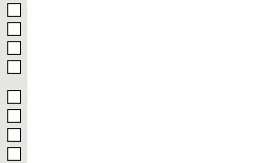




Section P |
Restraints and Alarms |
||
P0100. Physical Restraints |
|||
Physical restraints are any manual method or physical or mechanical device, material or equipment attached or adjacent to the resident's body that the individual cannot remove easily which restricts freedom of movement or normal access to one's body |
|||
Coding:
|
Enter Codes in Boxes |
||
|
Used in Bed |
||
|
A. Bed rail. |
||
B. Trunk restraint |
|||
C. Limb restraint |
|||
D. Other |
|||
Used in Chair or Out of Bed |
|||
E. Trunk restraint |
|||
F. Limb restraint. |
|||
G. Chair prevents rising. |
|||
H. Other |
|||
Section Q |
Participation in Assessment and Goal Setting |
|
Q0400. Discharge Plan |
||
Enter Code |
A. Is active discharge planning already occurring for the resident to return to the community?
|
|
|
||
|
|
|
Section X |
Correction Request |
|
Complete Section X only if A0050 = 2 or 3 Identification of Record to be Modified/Inactivated - The following items identify the existing assessment record that is in error. In this section, reproduce the information EXACTLY as it appeared on the existing erroneous record, even if the information is incorrect. This information is necessary to locate the existing record in the National MDS Database. |
||
X0150. Type of Provider (A0200 on existing record to be modified/inactivated) |
||
Enter Code |
Type of provider
|
|
X0200. Name of Resident (A0500 on existing record to be modified/inactivated) |
||
|
A. First name:
C. Last name: |
|
X0300. Gender (A0800 on existing record to be modified/inactivated)
Enter Code
Male
Female
X0400. Birth Date (A0900 on existing record to be modified/inactivated)
_
Month
_
Day
|
|
|
|
Year
X0500. Social Security Number (A0600A on existing record to be modified/inactivated)


X0600. Type of Assessment (A0310 on existing record to be modified/inactivated)
Enter Code
Enter Code
Enter Code
Enter Code
Federal OBRA Reason for Assessment
Admission assessment (required by day 14)
Quarterly review assessment
Annual assessment
Significant change in status assessment
Significant correction to prior comprehensive assessment
Significant correction to prior quarterly assessment
99. None of the above
PPS Assessment.
PPS Scheduled Assessment for a Medicare Part A Stay.
5-day scheduled assessment
PPS Unscheduled Assessment for a Medicare Part A Stay
08. IPA - Interim Payment Assessment
Not PPS Assessment.
99. None of the above
F. Entry/discharge reporting
01. Entry tracking record
Discharge assessment-return not anticipated
Discharge assessment-return anticipated
Death in facility tracking record
99. None of the above
H. Is this a SNF Part A PPS Discharge Assessment?
No
Yes
X0700. Date on existing record to be modified/inactivated - Complete one only.
Assessment Reference Date (A2300 on existing record to be modified/inactivated) - Complete only if X0600F = 99
_
Month
_
Day
|
|
|
|
Year
Discharge Date (A2000 on existing record to be modified/inactivated) - Complete only if X0600F = 10, 11, or 12
_
Month
_
Day
|
|
|
|
Year
Entry Date (A1600 on existing record to be modified/inactivated) - Complete only if X0600F = 01
_
Month
_
Day
|
|
|
|
Year
Correction Attestation Section - Complete this section to explain and attest to the modification/inactivation request
X0800. Correction Number
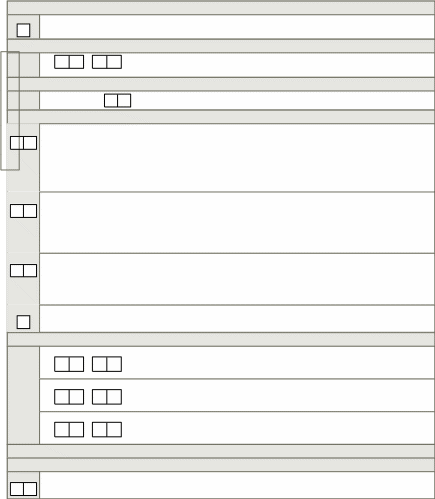
Enter Number
Enter the number of correction requests to modify/inactivate the existing record, including the present one


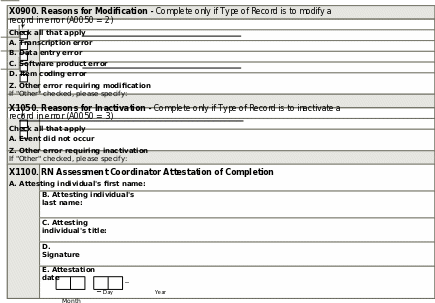

Section Z |
Assessment Administration |
|
Z0300. Insurance Billing |
||
|
|
|
Section Z |
Assessment Administration |
||||
Z0400. Signature of Persons Completing the Assessment or Entry/Death Reporting |
|||||
|
I certify that the accompanying information accurately reflects resident assessment information for this resident and that I collected or coordinated collection of this information on the dates specified. To the best of my knowledge, this information was collected in accordance with applicable Medicare and Medicaid requirements. I understand that this information is used as a basis for ensuring that residents receive appropriate and quality care, and as a basis for payment from federal funds. I further understand that payment of such federal funds and continued participation in the government-funded health care programs is conditioned on the accuracy and truthfulness of this information, and that I may be personally subject to or may subject my organization to substantial criminal, civil, and/or administrative penalties for submitting false information. I also certify that I am authorized to submit this information by this facility on its behalf. |
||||
Signature |
Title |
Sections |
Date Section Completed |
||
A. |
|
|
|
||
B. |
|
|
|
||
C. |
|
|
|
||
D. |
|
|
|
||
E. |
|
|
|
||
F. |
|
|
|
||
G. |
|
|
|
||
H. |
|
|
|
||
I. |
|
|
|
||
J. |
|
|
|
||
K. |
|
|
|
||
L. |
|
|
|
||
Z0500. Signature of RN Assessment Coordinator Verifying Assessment Completion |
|||||
|
A. Signature: B. Date RN Assessment Coordinator signed assessment as complete: _ _ Month Day Year |
||||




Legal Notice Regarding MDS 3.0 - Copyright 2011 United States of America and interRAI. This work may be freely used and distributed solely within the United States. Portions of the MDS 3.0 are under separate copyright protections; Pfizer Inc. holds the copyright for the PHQ-9; Confusion Assessment Method. © 1988, 2003, Hospital Elder Life Program. All rights reserved. Adapted from: Inouye SK et al. Ann Intern Med. 1990; 113:941-8. Both Pfizer Inc. and the Hospital Elder Life Program, LLC have granted permission to use these instruments in association with the MDS 3.0.
MDS 3.0
Swing Bed
Discharge (SD)
Version 1.17.2
Effective
10/01/2020
Page


| File Type | application/vnd.openxmlformats-officedocument.wordprocessingml.document |
| File Title | MDS 3.0 Swing Bed Discharge (SD) Item Set |
| Subject | MDS 3.0 assessment items for swing bed Discharge assessments |
| Author | Centers for Medicare & Medicaid Services |
| File Modified | 0000-00-00 |
| File Created | 2023-09-02 |
© 2025 OMB.report | Privacy Policy